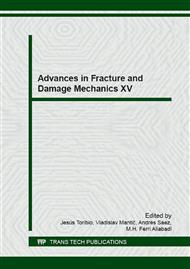p.284
p.288
p.293
p.297
p.301
p.305
p.309
p.313
p.317
Effect of the Crack Surface Friction on the Field Strength of Bi-Material-Interfacial Crack
Abstract:
The stress field, displacement field and stress intensity factor are discussed based on elastic theory in this paper. The finite element model for interface crack of bi-material is set up, the friction phenomena of interface between two materials is simulated. The effect of crack size ratio and friction factor of crack surface on crack tip displacement, equivalent effective stress and stress intensity factor are analyzed. The results show that with the increase of the crack surface friction coefficient, the displacement and equivalent effective stress of the crack tip, and stress intensity factor will also increase under the condition of the same crack size. If the crack surface friction is ignored, the results will be not precise and are not in conformity with the practical engineering, even the significant impacts will disappear in the research for crack initiation, extension and fracture.
Info:
Periodical:
Pages:
301-304
Citation:
Online since:
September 2016
Authors:
Price:
Сopyright:
© 2016 Trans Tech Publications Ltd. All Rights Reserved
Share:
Citation:


